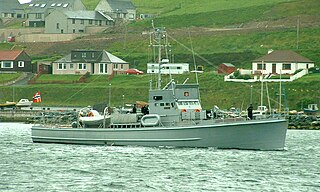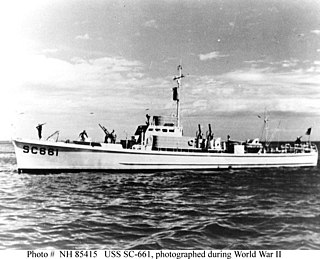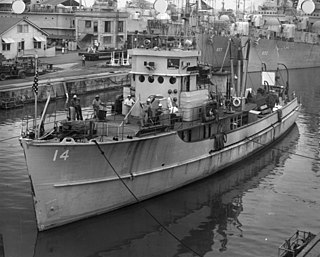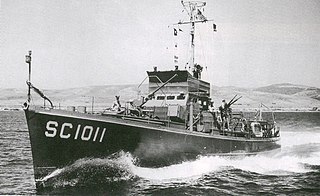
A submarine chaser or subchaser is a small naval vessel that is specifically intended for anti-submarine warfare. Many of the American submarine chasers used in World War I found their way to Allied nations by way of Lend-Lease in World War II.

A submarine chaser or subchaser is a small naval vessel that is specifically intended for anti-submarine warfare. Many of the American submarine chasers used in World War I found their way to Allied nations by way of Lend-Lease in World War II.
U.S. Navy submarine chasers were designed specifically to destroy German submarines in World War I, and Japanese and German submarines in World War II. The small 110-foot (34 m) SC-1-class submarine chasers of the design used in World War I carried the hull designator SC (for Submarine Chaser). [1] Their main weapon was the depth charge. They also carried machine guns and anti-aircraft guns. The similar-sized SC-497-class was built for World War II. Also in World War II, larger 173-foot (53 m) PC-461-class submarine chasers used the PC hull classification symbol (for Patrol, Coastal). [2]
Class relationships:
In early 1915, the British Admiralty selected the US Electric Launch Company (Elco) for the production of 50 motor launches for anti-submarine work, British industry being at maximum capacity. This order was eventually increased by a further 530. The whole order was completed by November 1916, and the vessels entered Royal Navy service. The vessels were 80 feet (24 m) in length and capable of 20 knots (37 km/h). They were armed with a 3-pounder gun, towed paravanes to attack submarines and, later, depth charges. [3] Additional motor launches of the Fairmile A, Fairmile B and other classes were built for World War II. [4]
The British sub chasers were operated around the coast in defence. However, they were uncomfortable, wet and not suited to British sea conditions.[ citation needed ] Although used during the First World War, they were sold when the war ended.
Submarine chasers were used mostly by the United States Coast Guard in World War II for destroying German U-boats that were stationed off the coast of the United States that were trying to sink merchant convoys as they departed American ports. In the Pacific Theatre, submarine chasers were used for amphibious landings, courier and escort duty. [5] [6] [2]
Eight British Fairmile B motor launches were transferred from Canada to the US in World War II, and included the SC-1466 class of sub-chasers. [7] [4]
The Imperial Japanese Navy had around 250 submarine chasers in World War II, principally about 200 of the No.1-class auxiliary submarine chasers. Some of these survived to serve in the Japan Maritime Self Defense Force (JMSDF) after the war. [8]
During Project Hula, the United States secretly transferred 32 U.S. Navy submarine chasers to the Soviet Union between 26 May and 2 September 1945, and some of these saw action in the Soviet Navy during Soviet military operations against the Japanese between 9 August and 2 September 1945. The transfer of 24 more was canceled when transfers halted on 5 September 1945, three days after the Japanese surrender. Between 1954 and 1960 all 32 transferred submarine chasers were scrapped by the Soviet Union or destroyed off its coast by mutual agreement between the two countries. [9]
In the decade immediately after World War II, the Soviet Union built 227 Kronshtadt-class submarine chasers, some of which remained in active service until the 1990s. Rapid developments in submarine technologies since World War II mean that submarine chasers are now obsolete, having been replaced by corvettes, frigates, and destroyers.
The only remaining submarine chaser with intact World War II armament is the Royal Norwegian Navy's HNoMS Hitra, which is a touring museum today. A World War II type submarine chaser built in 1953, originally PC1610, is being restored in the Netherlands as Le Fougueux. [10]

The Admirable class was one of the largest and most successful classes of minesweepers ordered by the United States Navy during World War II. Typically, minesweepers detected and removed naval mines before the rest of the fleet arrived, thereby ensuring safe passage for the larger ships. They were also charged with anti-submarine warfare (ASW) duties with rear-mounted depth charge racks and a forward-firing Hedgehog antisubmarine mortar. Their job was essential to the safety and success of U.S. naval operations during World War II and the Korean War. These minesweepers were also employed as patrol vessel and convoy escorts.

The British Royal Navy operated large numbers of small Motor Minesweepers (MMS) during the Second World War, in two major classes: the first with 105 ft (32 m) hulls and the second with 126 ft (38 m) hulls. Intended to counter magnetic influence mines in coastal waters, they had wooden hulls.

HNoMS Hitra is a Royal Norwegian Navy submarine chaser that saw action during World War II. She is named after the Norwegian island of Hitra.

The Fairmile B motor launch was a very numerous class of motor launch produced in kit form by British boatbuilder Fairmile Marine, and then assembled and fitted out by numerous boatyards during the Second World War to meet the Royal Navy's coastal operation requirements.

Naval trawlers are vessels built along the lines of a fishing trawler but fitted out for naval purposes; they were widely used during the First and Second World Wars. Some—known in the Royal Navy as "Admiralty trawlers"— were purpose-built to naval specifications, others adapted from civilian use. Fishing trawlers were particularly suited for many naval requirements because they were robust vessels designed to work heavy trawls in all types of weather, and had large clear working decks. A minesweeper could be created by replacing the trawl with a mine sweep. Adding depth charge racks on the deck, ASDIC sonar below, and a 3-inch (76 mm) or 4-inch (102 mm) gun in the bow equipped the trawler for anti-submarine duties.

The SC-497-class submarine chasers were a class of 438 submarine chasers built primarily for the United States Navy from 1941–1944. The SC-497s were based on the experimental submarine chaser, USS SC-453. Submarine chasers of this variety were collectively nicknamed "the splinter fleet" due to their wooden hulls.

The SC-1 class was a large class of submarine chasers built during World War I for the United States Navy. They were ordered in very large numbers in order to combat attacks by German U-boats, with 442 boats built from 1917 to 1919.

The HNoMS Vigra was a Royal Norwegian Navy submarine chaser that saw action during World War II. She was named after the Norwegian island of Vigra.

The HNoMS Hessa was a Royal Norwegian Navy submarine chaser that saw action during World War II. She was named after the Norwegian island of Hessa.

Project Hula was a program during World War II in which the United States transferred naval vessels to the Soviet Union in anticipation of the Soviets eventually joining the war against Japan, specifically in preparation for planned Soviet invasions of southern Sakhalin and the Kuril islands. Based at Cold Bay in the Territory of Alaska, the project was active during the spring and summer of 1945. It was the largest and most ambitious transfer program of World War II.

The PCE-842-class patrol craft escort was a United States Navy (USN) ship class of submarine chasers designed during World War II. The PCE-842-class were the only vessels ever designated by the USN as the 'patrol craft escort' (PCE) type. The PCE design was derived from the 180-foot (55 m) Admirable-class minesweeper to complement the 173-foot (53 m) PC-461-class submarine chasers that were used for anti-submarine warfare (ASW) in coastal areas. At 185 feet long and 640 tons, the PCE is more than twice the displacement of the PC but with a less powerful engine also much slower; however, because of its larger size, the PCE was able to undertake longer-range tasks over PC-461-class vessels. The USN envisaged the PCE as enabling PCs and smaller vessels to undertake coastal patrols without being called-upon as often to perform open ocean and convoy escort duties, while simultaneously freeing-up some larger vessels - such as destroyer escorts and destroyers - from convoy ASW duties. The PCE-482-class had a standard crew complement of 99 officers and men. The class would ultimately see 68 total vessels built, serving with multiple navies around the world.

The Japanese submarine chaser CH-2 was a No.1-class submarine chaser of the Imperial Japanese Navy during World War II. Built by Mitsubishi Heavy Industries, Yokohama, she was completed on 25 March 1934.

The Roofdier class was a class of six frigates that were built in the United States as Patrol Craft Escorts (PCE) for the Netherlands. The frigates were loaned to the Royal Netherlands Navy as part of the Mutual Defense Assistance Act (MDAP) and from 1954 to 1984 served as the Roofdier-class frigates.

The Canadian Fairmile B was a motor launch built during the Second World War for the Royal Canadian Navy. They were adaptations of the British Fairmile B motor launch design incorporating slight modifications for Canadian climatic and operational conditions. Eighty-eight were built in Canada for service with the Coastal Forces of the Royal Canadian Navy in home waters, of which eight were supplied to the United States Navy.

South Coast Shipyard was a shipbuilding company in Newport, California. To support the World War II demand for ships South Coast Shipyard built: minesweepers, Torpedo Boats, Submarine chasers, & Air-sea rescue boats. South Coast Shipyard was opened in 1938 by Walton Hubbard. After World War II the shipyard continued to build ships for the US Navy till 1955. The shipyard was located at 2300 Newport Boulevard, Newport, California. The shipyard closed in 1963.

Victory Shipbuilding was the name of two shipbuilding companies that built vessels during World War 2. The first was the Victory Shipbuilding Company, of Holland, Michigan, and the second was the Victory Shipbuilding Corporation, of Newport Beach, California.

Splinter fleet or Splinter navy was a nickname given to the United States wooden boats used in World War II. The boats served in many different roles during the war. These boats were built in small boatyards on the West coast and East coast, Great Lakes and the Gulf of Mexico. They could be built quickly, in just 60 to 120 days. Most of the boats were built by boatyards that already had the tools and knowledge from building yachts, sailboats and motor boats. Many were built by craftsmen in family-owned small businesses. Under the Emergency Shipbuilding Program and War Shipping Administration contracts went out to over fifty boatyards across the country. The boats were built for the US Navy, the United States Army Air Forces, United States Coast Guard, and US Army. Some of the wooden boats went to Allied nations on the Lend-Lease program.